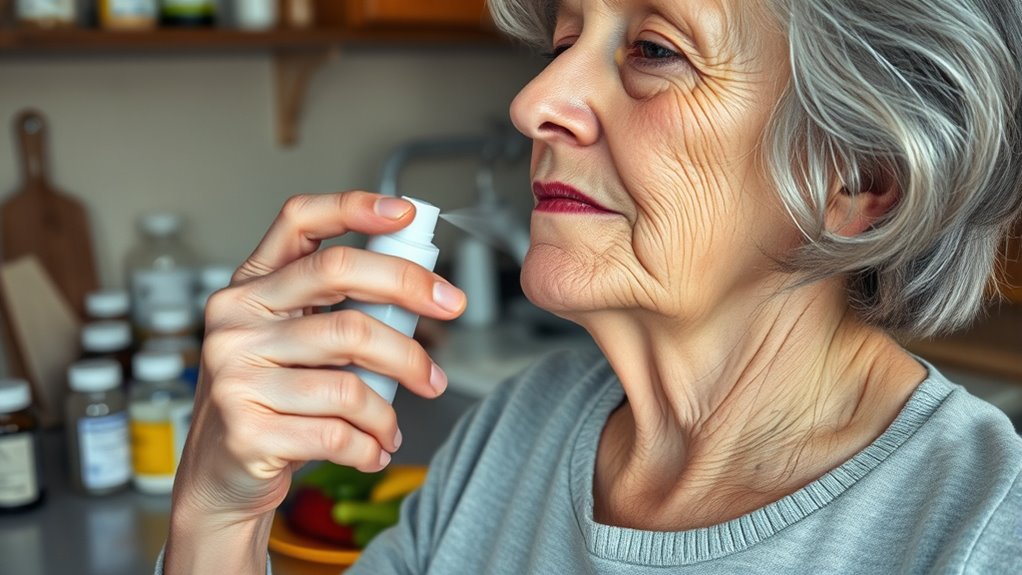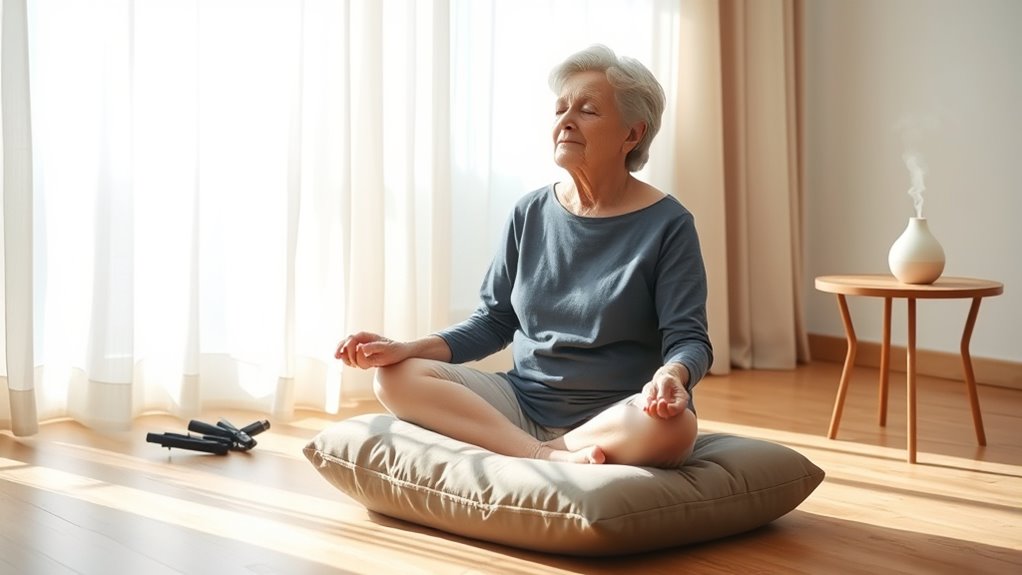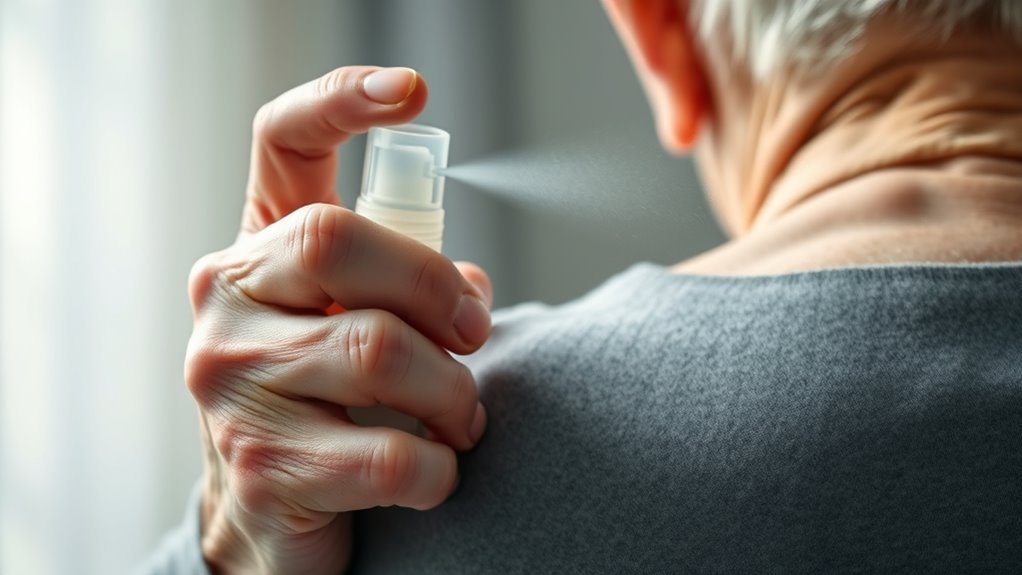Many seniors rely too heavily on over-the-counter medications to hide pain, thinking it’s an easy fix. This approach can mask underlying issues and lead to health risks if misused. Instead, you should focus on addressing the root causes of pain through natural remedies, gentle exercise, and holistic care techniques. By understanding more, you can learn how to manage pain safely and effectively for better long-term relief.
Key Takeaways
- Relying solely on OTC medications without addressing underlying causes of pain.
- Ignoring the importance of holistic, natural, or alternative therapies alongside medications.
- Failing to seek professional medical advice before self-medicating or trying remedies.
- Overusing prescription pain relievers beyond prescribed dosages, risking dependency and side effects.
- Neglecting emotional and mental health factors that contribute to chronic pain management.
Relying Too Much on Over-the-Counter Medications

Many seniors rely heavily on over-the-counter pain medications, believing they’re a safe and easy way to manage discomfort. However, this approach can lead to dependency and mask underlying issues. Instead, consider exploring herbal remedies, which can offer natural relief with fewer side effects. Additionally, chiropractic care can address misalignments and improve overall spinal health, reducing pain without medication. These alternatives often target the root causes of discomfort more effectively than simply taking pills. Incorporating vetted natural remedies into your routine can provide safer, more sustainable relief. Relying solely on over-the-counter meds may provide temporary relief, but it doesn’t tackle the underlying problem. By integrating herbal remedies and chiropractic adjustments into your pain management routine, you can enhance your well-being and reduce the risks associated with long-term medication use.
Ignoring the Root Cause of Pain

Relying solely on over-the-counter medications can mask the true source of your pain, leading you to treat symptoms rather than the underlying problem. Ignoring the root cause prevents you from exploring holistic healing options that address your overall well-being. Pain often signals deeper issues—be it physical, emotional, or mental—that need attention. By overlooking these signals, you risk worsening the condition or developing new problems. Emotional support plays a crucial role in healing, helping you process stress and emotional trauma that could be intensifying your pain. Instead of just masking discomfort, seek a thorough approach that identifies and addresses the true cause. Utilizing vibrational alignment techniques can help you understand and release emotional blocks contributing to your pain. This way, you give yourself a better chance at long-term relief and improved health.
Underestimating the Power of Physical Activity

Even though pain might make movement uncomfortable, physical activity remains one of the most effective ways to manage and reduce it. Many seniors underestimate its power, thinking rest is best. However, gentle stretching and outdoor walking can improve flexibility, boost circulation, and lessen pain over time. You don’t need intense workouts—small, consistent efforts make a difference. Incorporating GMC tuning techniques into your routine can also help optimize your body’s performance and reduce discomfort.
Skipping Professional Medical Advice

Skipping professional medical advice can lead to misdiagnosing your pain or missing serious health issues. Relying solely on self-diagnosis or alternative therapies without consulting a healthcare provider can be risky. While holistic approaches and alternative therapies may help manage pain, they shouldn’t replace professional evaluation. A doctor can identify underlying conditions that might be causing your discomfort, ensuring you receive appropriate treatment. Ignoring medical advice may delay vital interventions or lead to complications. Even if your pain seems minor, it’s imperative to get a proper diagnosis before trying new remedies. Recognizing the importance of proper diagnosis can prevent complications and ensure effective treatment. Remember, combining professional guidance with holistic strategies can offer safer, more effective relief. Don’t overlook the importance of expert advice when managing your health and pain.
Overlooking Natural and Alternative Therapies

While consulting a healthcare professional is essential, many seniors overlook the potential benefits of natural and alternative therapies. These therapies, such as herbal remedies and acupuncture techniques, can provide effective pain relief without relying solely on medications. By exploring these options, you may reduce side effects and address underlying issues more holistically.
Consider these benefits:
- Natural remedies can target specific pain points
- Acupuncture techniques stimulate your body’s healing response
- Herbal remedies may reduce inflammation
- Alternative therapies often have fewer side effects
- Combining approaches can enhance overall well-being
- Payment processing insights suggest that exploring various treatment options and ensuring proper management can lead to more effective pain relief strategies.
Don’t dismiss these options outright—discuss them with your healthcare provider to see if they fit into your pain management plan. Incorporating natural and alternative therapies can be a valuable addition to your pain relief strategy.
Neglecting the Importance of Proper Nutrition

When you ignore proper nutrition, your body may develop deficiencies that worsen pain and slow recovery. As you age, your appetite can decrease, making it harder to get essential nutrients. Eating a balanced diet can help manage pain better and support overall health. Incorporating mindful eating habits can also prevent nutrient deficiencies and promote better recovery.
Nutritional Deficiencies Impact
Neglecting proper nutrition can considerably worsen pain for seniors, as their bodies rely heavily on essential nutrients to manage inflammation and repair tissues. Vitamin deficiencies and mineral imbalances can impair healing, increase inflammation, and heighten pain sensitivity. When your body lacks key nutrients, it struggles to support joint health and muscle function. To combat this, focus on:
- Ensuring adequate intake of vitamin D and calcium for bone strength
- Consuming foods rich in magnesium and zinc to reduce inflammation
- Avoiding processed foods high in empty calories and additives
- Monitoring levels of B vitamins to support nerve health
- Maintaining balanced electrolytes to prevent muscle cramps and pain
- Selecting appropriate mattress toppers that provide support and comfort, which can aid in reducing pain during sleep.
Addressing these deficiencies helps restore proper bodily functions, reducing pain intensity and improving overall mobility. Proper nutrition isn’t just about health; it’s a crucial part of pain management.
Age-Related Appetite Changes
As you age, your appetite often diminishes, making it harder to consume enough nutrients necessary for pain management. Age-related appetite changes can lead to reduced food intake, which means you might miss out on crucial vitamins and minerals your body needs to heal and stay strong. You may also become less aware of senior hunger cues, which are your body’s signals that you need nourishment. Ignoring these cues can result in unintentional weight loss and nutritional gaps, worsening pain and slowing recovery. It’s important to recognize that your body’s needs change over time, and paying attention to your hunger signals is key. Properly addressing age-related appetite shifts helps ensure you get the nutrients essential for effective pain relief and overall well-being. Understanding nutrition is vital to adapting your diet as your needs evolve.
Balanced Diet Benefits
Have you ever considered how a balanced diet directly impacts your ability to manage pain? Proper nutrition provides your body with essential nutrients that support joint health, reduce inflammation, and boost your energy. When you focus on nutrient timing and meal planning, you can better control blood sugar levels and prevent energy crashes, which may worsen pain. A well-balanced diet includes foods rich in omega-3s, antioxidants, vitamins, and minerals that promote healing and resilience. To maximize benefits, consider these key points:
- Eat regular, nutrient-dense meals
- Incorporate anti-inflammatory foods
- Avoid processed, sugary snacks
- Balance carbs, protein, and healthy fats
- Stay hydrated for ideal nutrient absorption
Consuming dog names that are rich in omega-3s, like salmon or flaxseeds, can further support your anti-inflammatory efforts. Neglecting proper nutrition can hinder pain management and overall health. Prioritize a balanced diet to support your body’s healing process and maintain mobility.
Misusing Prescription Pain Relievers

Misusing prescription pain relievers can lead to serious health risks, especially if you overuse medications or ignore dosage instructions. Combining drugs without guidance can dangerously amplify side effects or interactions. Staying informed and following your doctor’s directions helps you avoid these common mistakes. Additionally, being aware of home decor tips can create a comfortable environment that supports overall well-being.
Overusing Medications Risks
Overusing prescription pain relievers can pose serious health risks for seniors. When you take more medication than prescribed or use them longer than advised, you increase your chances of experiencing medication side effects and developing drug dependency. These risks include dizziness, nausea, confusion, and even respiratory issues. It’s essential to recognize that overuse can also mask underlying problems, delaying proper treatment. Be cautious and always follow your doctor’s instructions. Consider these points: best modern toilet
- Increased risk of medication side effects
- Greater potential for drug dependency
- Higher chance of falls or accidents
- Adverse interactions with other medications
- Reduced effectiveness over time
Ignoring Dosage Instructions
Ignoring dosage instructions can lead seniors to take more or less medication than prescribed, which can be dangerous. If you don’t follow the recommended medication timing and dosage accuracy, you risk overdose or ineffective pain relief. Properly measuring and timing your pills ensures safety and effectiveness. Additionally, understanding home cinema setup and technology can help create a comfortable environment for recovery and relaxation.
Combining Drugs Dangerously
Combining prescription pain relievers without medical guidance can be extremely dangerous because it increases the risk of severe side effects, overdose, and even death. Mixing medications without understanding drug interactions jeopardizes your medication safety and can lead to unpredictable health problems. You might unintentionally amplify side effects or reduce the effectiveness of treatments. Always consult your healthcare provider before combining any drugs. Be aware of these risks:
- Hidden drug interactions that worsen side effects
- Increased chance of overdose
- Unintended effects on your organs
- Reduced medication efficacy
- Dangerous complications from combining opioids and sedatives
Taking multiple medications without proper guidance puts your health at serious risk. Prioritize medication safety by always seeking professional advice before adjusting your pain relief regimen. Cybersecurity vulnerabilities during outages highlight the importance of protecting your health information and medication records from potential threats.
Failing to Incorporate Mind-Body Techniques

Many seniors overlook the benefits of mind-body techniques, even though these practices can substantially reduce pain and improve overall well-being. Techniques like mindfulness meditation help you stay present, easing stress and lowering pain levels. Incorporating even a few minutes daily can make a big difference. Imagine a table illustrating how different practices target pain points:
| Technique | Focus Area | Benefit |
|---|---|---|
| Mindfulness Meditation | Stress reduction | Calms the mind |
| Deep Breathing | Anxiety relief | Eases muscle tension |
| Guided Imagery | Pain management | Promotes relaxation |
Engaging in meditation and other spiritual practices can elevate your mental resilience and contribute to a more peaceful, pain-free life.
Ignoring the Benefits of Regular Exercise and Stretching

Regular exercise and stretching are essential for managing pain and maintaining mobility, yet seniors often underestimate their importance. Incorporating stretching routines and maintaining exercise consistency can dramatically improve flexibility and reduce discomfort. When you neglect these activities, muscles weaken, joints stiffen, and pain worsens over time. To stay active, focus on:
Regular exercise and stretching are vital for mobility and pain relief as we age.
- Consistent stretching routines tailored to your needs
- Gentle aerobic activities like walking or swimming
- Strengthening exercises to support joints
- Flexibility practices to prevent stiffness
- Listening to your body to avoid overexertion
Mindfulness techniques can also help seniors develop a greater awareness of their physical sensations, making it easier to recognize when to rest or adjust activity levels.
Not Adapting Daily Routines to Reduce Strain

You might be pushing yourself during morning routines or household chores without realizing the strain it causes. By reevaluating your daily activities, you can find ways to make them gentler and easier to manage. Simplifying personal care and adjusting tasks can markedly reduce pain and boost your comfort.
Reevaluate Morning Activities
Starting your mornings without reevaluating your activities can lead to unnecessary strain and pain. Simple adjustments can make a big difference. For example, incorporate a calming morning meditation to set a relaxed tone, and establish hydration routines to prevent stiffness. Reassess your schedule to avoid rushing or strenuous tasks early in the day. Consider these tips:
- Slow down your morning pace
- Use ergonomic tools for stretching or movement
- Prioritize gentle exercises like walking or yoga
- Incorporate brief, mindful meditation sessions
- Drink water first thing to stay hydrated
- Creating a personalized work environment can boost motivation and reduce physical strain.
Adjust Household Tasks
Reevaluating your morning activities is a great first step, but it’s equally important to adjust household tasks to prevent unnecessary strain. Small task modifications can make a big difference in maintaining household safety and reducing pain. For example, you might raise shelves, use ergonomic tools, or switch to lightweight cleaning supplies. Avoid twisting or reaching awkwardly, and consider using assistive devices to handle heavy lifting. These adjustments help you stay independent while protecting your joints and muscles. Focus on creating a safer environment by removing hazards and making everyday chores more manageable. By proactively adapting your routines, you lower the risk of injury and pain, ensuring you can continue handling household tasks comfortably and confidently. Incorporating creative problem-solving into these adjustments can help find innovative solutions that suit your specific needs.
Simplify Personal Care
Simplifying your personal care routines can considerably reduce strain on your joints and muscles. Small adjustments make a big difference in managing pain and maintaining independence. For example, you can:
- Use ergonomic tools like long-handled brushes for personal hygiene
- Switch to gentle, moisturizing skincare routines to avoid excessive scrubbing
- Opt for no-rinse cleansers to save time and effort
- Keep skincare and hygiene products within easy reach
- Limit the number of steps in your routines to prevent fatigue
- Incorporating textile art techniques such as using textured fabrics can help create more accessible and engaging personal care tools.
Frequently Asked Questions
How Can I Identify the True Cause of My Pain?
To identify the true cause of your pain, start with a thorough pain assessment, noting when, where, and how strongly you feel discomfort. Keep detailed symptom tracking to spot patterns or triggers. Share this information with your healthcare provider, who can analyze your data and perform necessary tests. This proactive approach helps pinpoint the root cause more accurately, leading to more effective treatment and relief.
Are Natural Remedies Effective for Chronic Pain Management?
A stitch in time saves nine, so you might wonder if natural remedies work. Herbal supplements and acupuncture therapy can be effective for chronic pain, but results vary. They often provide relief without side effects of medications. However, it’s crucial to consult with a healthcare provider first to guarantee safety and proper use. Natural options can complement your pain management plan, but they’re not a one-size-fits-all solution.
When Should I See a Specialist About My Pain?
You should see a specialist about your pain if it persists despite natural remedies or worsens over time. Don’t wait—schedule a pain assessment with a healthcare professional to identify underlying causes. A specialist consultation can provide targeted treatment options, improve your quality of life, and prevent complications. Trust your instincts; early intervention is key to managing chronic pain effectively and avoiding unnecessary suffering.
What Lifestyle Changes Can Help Reduce Pain Long-Term?
You can reduce pain long-term by making simple lifestyle changes. Focus on diet adjustments, like eating anti-inflammatory foods such as fruits, vegetables, and omega-3 rich fish. Prioritize sleep hygiene by establishing a consistent bedtime and creating a relaxing sleep environment. Regular gentle exercise also helps, but always check with your doctor first. These habits support your body’s healing process and can markedly decrease pain over time.
How Do Mind-Body Techniques Complement Physical Therapy?
Think of your mind-body connection as a symphony where each instrument influences the others. Mind-body techniques, like deep breathing or meditation, harmonize with physical therapy, enhancing healing. These holistic approaches address pain’s root causes, not just symptoms. They help you stay engaged in your recovery, making physical therapy more effective and empowering. Incorporating these techniques can turn your pain management into a balanced, concerted effort for better long-term relief.
Conclusion
Don’t let pain become a shadow you chase endlessly. Instead, see it as a signpost guiding you toward better habits and mindful choices. By addressing root causes, embracing gentle movement, and seeking professional advice, you can break free from the cycle of temporary fixes. Remember, your body’s whispers today can prevent louder cries tomorrow—listen carefully, act wisely, and turn the page to a pain-free chapter.








